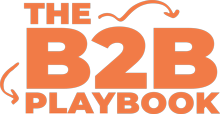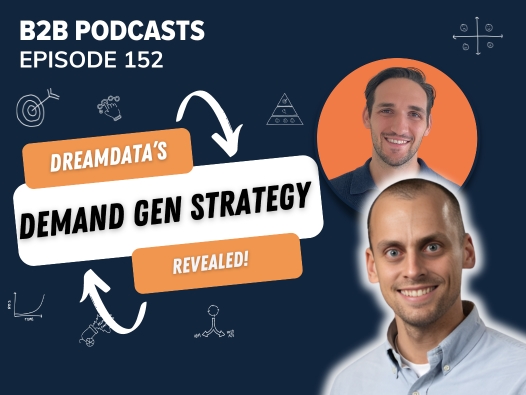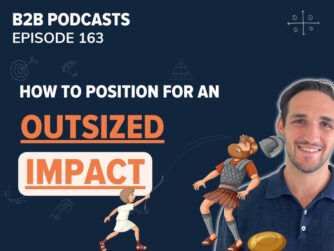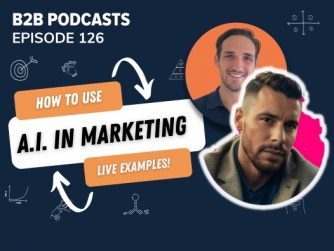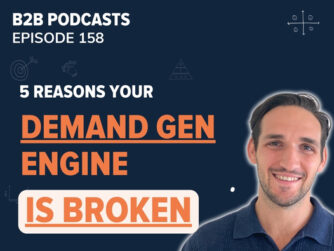B2B can feel so much harder than B2C at times. B2B buying cycles can stretch on for months, involving countless touchpoints and stakeholders. It’s easy to feel like you’re running in circles, pouring resources into campaigns that take forever to show results.
That’s why a solid demand generation strategy is so important in the B2B world. If you’re a follower of The B2B Playbook, you know it’s about more than just generating leads. It’s about creating meaningful relationships that pay off in the long run. To show you what this looks like in practice, we caught up with Steffen Hedebrandt, Co-founder and CMO of Dreamdata, who’s mastered the art of balancing short-term wins with sustainable growth.
Steffen doesn’t just talk theory—he shares real-world tactics and insights that you can apply to your business today. As per usual, you can watch, listen to or read all about how Dreamdata have grown with Demand Generation below!
Listen To The Episode
Watch The Episode
Understanding the B2B Buying Journey
Dreamdata’s own research shows that sales B2B journeys are long and complex.
“The general benchmark that we’ve put out is that the average journey takes from the first touch to a won account is 192 days,”
Steffen Hedebrandt – The B2B Playbook
That’s right, folks—we’re talking about a whopping six months from first contact to closing the deal. And if you’re dealing with larger companies or bigger deal sizes? Brace yourself, because “the deal cycle, the customer journey time goes up even from there”.
Dreamdata’s research also shows that the typical B2B journey involves 62 sessions per deal, more than three people involved in every deal. If you’re looking your your CRM and it shows your sales cycle is much shorter – maybe it only takes 3 months to close a deal – there’s a good chance you’re just looking at the sales cycle, not the purchasing journey. The sales cycle is only tracking the time from when that company became an opportunity in your pipeline. It doesn’t take into account when they were earlier in their journey before they entered your database. There’s a whole lot of research and consideration happening before that first sales call even takes place.
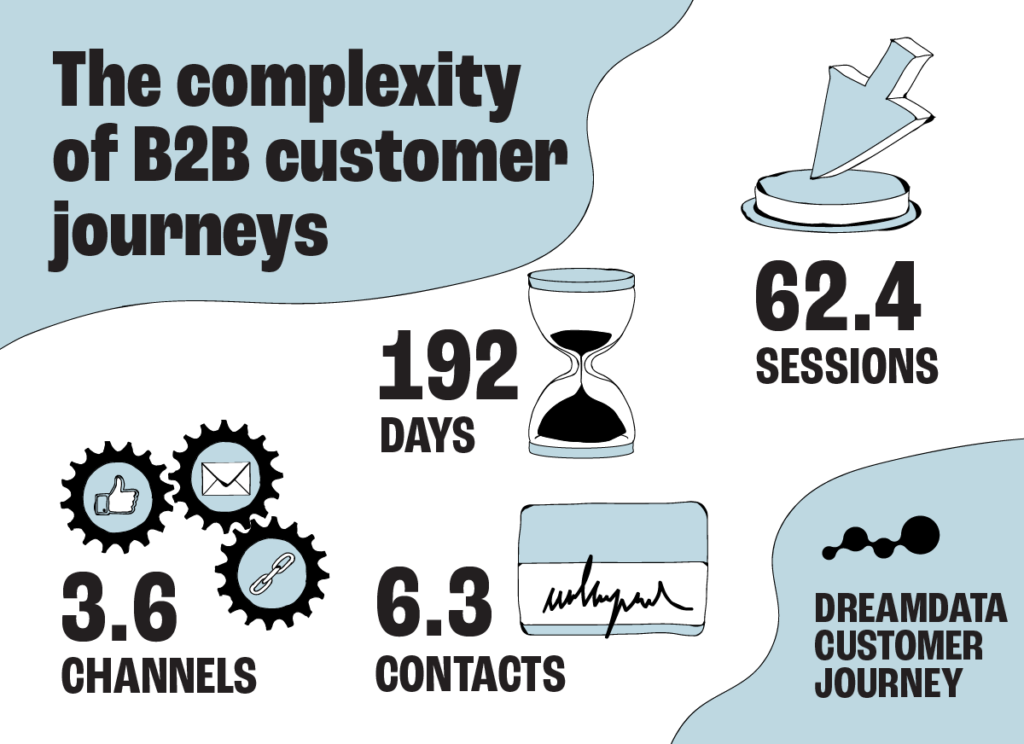
So, what does this mean for us B2B marketers? Well, for starters, it means we need to start planting seeds early. As Steffen points out,
“Any extra revenue you’re going to generate this year, you have to start marketing activities right now”
Steffen Hedebrandt – The B2B Playbook
We’re not just talking about next quarter—we’re talking about influencing decisions that might not bear fruit until next year.
The challenge of course for us B2B marketers is to prove the value that we create because our activities lie early in the journey. We’re playing the long game, folks. Our job isn’t just about booking demo calls; it’s about getting in front of the right accounts, creating demand and building success cases that they trust enough for the sales team to get that sales meeting booked.
Understanding this extended B2B buying journey is crucial. It means we need to be present and valuable at every stage, from that very first touch point all the way through to the final signature. It’s a marathon, not a sprint, and it’s time we started training accordingly.
Building a Foundation for Demand Generation
Now that we’ve got our heads around the marathon that is the B2B buying journey, let’s talk about laying the groundwork for your demand generation strategy. Spoiler alert: it all starts with knowing exactly who you’re trying to reach.
This starts with identifying who your best customers are, and writing down your Ideal Customer Profile.
“You need to write down what’s your ideal customer profile. You not do that because otherwise you’re going to be firing in all different kinds of directions”
Steffen Hedebrandt – The B2B Playbook
Folks, this isn’t just good advice—it’s the cornerstone of your entire demand gen strategy.
Think about it: how can you create demand if you don’t know who you’re creating it for?
Steffen also suggests that defining your ICP isn’t just a marketing exercise—it’s a company-wide alignment tool. For example, we know who marketing is trying to attract, who sales is trying to sell to, who customer success needs to be focussing on, who the product team should be building new features for. It’s about getting everyone singing from the same hymn sheet.
I couldn’t agree more. This is exactly why we help you do this in part 1 of our Demand Generation Course. Your life as a marketer is so much easier when the team around you is aligned on who your ICP is.
Start By Capturing Existing Demand
Now, once you’ve got your ICP nailed down, it’s time to start capturing existing demand out there for your product or service. Research shows that 5% of the market is in ‘buy-mode’, and it’s your job as the marketer to try and get in front of them to start with. A great place to start here can be laser-focused Google Search Ads, and leveraging review platforms like G2 and Capterra, as well as tech marketplaces.
“You actually get in front of people who are out there buying right now, just by making sure you collect reviews from your happy customers”
Steffen Hedebrandt – The B2B Playbook
Steffen then shared a great tip – recommending that after you see which phrases work best in Google Search Ads, to then write pieces of content based on that to grab the organic traffic coming from Google too. It’s a beautiful cycle—your paid ads inform your content strategy, which then boosts your organic reach. Genius!
Building this foundation isn’t a one-and-done deal. It’s about constantly refining your ICP, optimizing your bottom-of-funnel tactics, and using the insights you gain to fuel your broader demand generation strategy. It’s like building a house—get the foundation right, and everything else becomes so much easier.
Creating and Capturing Demand: A Balanced Approach
A successful demand generation strategy isn’t just about immediate wins; it’s about playing the long game. At Dreamdata, the team have mastered the art of balancing short-term demand capture with long-term demand creation. Let’s go through some of their Demand Creation strategies.
Account Based Marketing
Part of Dreamdata’s demand creation strategy involves account-based marketing and content strategies designed to keep their brand top of mind with potential buyers. This helps keep people aware of their product and solution before they step into the buying cycle. This proactive approach ensures that when those prospects are ready to make a purchase, Dreamdata is already on their radar.
A key component of this strategy is Dreamdata’s use of LinkedIn’s matched audiences for account-based marketing. By carefully targeting the right accounts and job titles, they ensure their message reaches the most relevant prospects—even if those prospects aren’t immediately ready to buy.
Content Collaboration and Repurposing
Collaboration and content repurposing is another pillar of Dreamdata’s demand generation strategy. Recognizing the value of partnerships, Dreamdata regularly collaborates with industry experts and influencers to create high-quality content that resonates deeply with their target audience. They do this with their weekly live show on LinkedIn. These collaborations are not just about sharing knowledge; they’re about leveraging the reach and credibility of well-respected voices in the industry. As Steffen Hedebrandt explains,
“We create awareness because… sometimes it’s 500 or 1,000 people that are watching live”
Steffen Hedebrandt – The B2B Playbook

But Dreamdata doesn’t stop there. They maximize the impact of this content by repurposing it across multiple channels. For instance, a single live event with an industry leader is turned into a podcast episode, a blog post, and several social media snippets. This content recycling ensures that their message reaches a broader audience without needing to continuously create new material from scratch.
This is the exact same approach we take at The B2B Playbook. Notice how this article you’re reading is about a podcast recording we had with Steffen?
It’s a great strategy, because not only does it amplify the reach of their content but also positions Dreamdata as a thought leader in the B2B space. By consistently sharing valuable insights across various platforms, they build a steady stream of engagement, keeping their brand top-of-mind for potential customers.
Thought Leadership and Events
Dreamdata also use use their weekly live events as part of their account-based marketing strategy. They’re an opportunity for sales to warm up potential leads in a non-intrusive, value-driven way. For example, when a relevant guest is featured on the event, the sales team can use this opportunity to reach out to prospects with a tailored message, inviting them to join the conversation.
Dreamdata also strategically invites guests who are either potential clients or influential figures within their target market. By featuring these individuals in their events, Dreamdata creates a natural connection that can lead to future business opportunities. This approach allows them to build relationships with key decision-makers in a context that feels collaborative rather than transactional.
Social Selling
Social selling is also a key part of Dreamdata’s demand generation strategy. They’ve developed a disciplined approach to it that leverages the power of consistent, relevant content to nurture leads over time.
“We post relevant content in front of these people… so little by little, they get sucked into our funnel”
Steffen Hedebrandt – The B2B Playbook
The strategy involves more than just posting content. Dreamdata’s team is committed to expanding their network by connecting with ideal customer profiles (ICPs) and engaging them through thoughtful interactions. Every week, the team aims to exhaust the 100 connection requests allowed on LinkedIn, targeting individuals who fit their ICP criteria. Over time, this effort builds a robust network of potential buyers who regularly see Dreamdata’s content in their feeds. By consistently posting three to seven times a week, Dreamdata ensures that their brand remains top of mind, even if these prospects are not immediately ready to buy.
What sets Dreamdata’s social selling strategy apart is its integration with their broader marketing and sales efforts. The content shared on LinkedIn often ties back to other initiatives, such as their live events or collaborations with industry influencers. This creates a cohesive narrative across channels, reinforcing Dreamdata’s thought leadership and keeping their audience engaged.
The beauty of social selling is that it provides valuable feedback that the team uses to refine their messaging and approach, making social selling a dynamic and adaptive part of their overall strategy.
Leveraging Data for Demand Generation
Dreamdata of course use their own platform to understand what is and isn’t working as part of their Demand Generation efforts. Their software provides great insights into the whole customer journey, allowing you to pinpoint channels and activities are driving revenue and which are falling short.

Whether it’s tracking ad spend or evaluating the effectiveness of content, Dreamdata uses data to ensure that their demand generation strategy is both efficient and effective. As Steffen puts it,
“Your ad spend, the clicks you’re acquiring, do they move down through your sales funnel and become customers? This is something Dreamdata does extremely well”
Steffen Hedebrandt – The B2B Playbook
Importantly, Dreamdata also recognizes that not all marketing activities can be captured through data alone. They use qualitative insights, such as customer feedback and anecdotal evidence from sales conversations, to supplement their quantitative data. We definitely align with this holistic approach!
Experimentation: The Key to Finding New Growth Channels
It’s incredibly important to ‘stick to what works’ in B2B marketing. Too often I see constant experimentation, and not enough sustained activity for demand generation to have an impact. Steffen makes a great point that it’s important to double down on proven strategies. This then gives you the cash to invest into experiments to help push the next fronteir of growth.
“It’s a constant duality between keeping exhausting what’s working and… finding the next kind of oil that will drive your growth”
Steffen Hedebrandt – The B2B Playbook
The danger of relying too heavily on a single channel is real. If you wait until you’ve fully exhausted it, you risk hitting a growth roadblock. Dreamdata sidesteps this by always being on the lookout for new opportunities before they become a necessity. It’s about staying ahead of the curve and making sure your growth engine never stalls.
For small-team B2B marketers: keep pushing the envelope, but make sure your core is rock solid. By balancing what’s proven with what’s possible, you can drive sustainable growth and stay ahead.
Next Steps For You
Surprise, surprise! Dreamdata confirms that there’s truly no ‘silver bullet’ to B2B demand generation. Success comes from a deep understanding of your target market, and playing the long game – knowing that the demand you create today might not bear fruit for months. But when it does, it will be because you laid the groundwork with intention and precision.
- Create and Capture Demand Simultaneously: Balance your efforts between capturing immediate demand from high-intent prospects and building long-term demand through strategic content and brand awareness initiatives.
- Focus on What Works, But Always Experiment: Double down on proven strategies to fund experiments with new growth channels, ensuring you stay ahead without hitting a plateau.
- Leverage Data to Optimize and Measure Success: Use data to track the entire customer journey, optimize marketing activities, and make informed decisions that drive long-term growth.
If you want a set process for building your Demand Generation Engine to create and capture demand, check out our 12 Week Demand Generation Program – The B2B Incubator.
